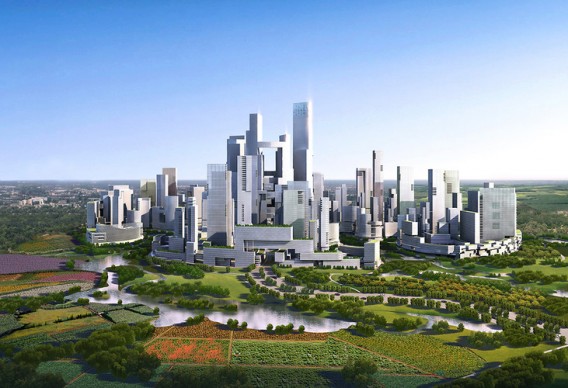















November 18, 2012 | permalink

(Originally published at Co.Exist on November 16, 2012.)
In 1902, a self-taught urban planner named Ebenezer Howard published his utopian vision for “Garden Cities”—self-contained circular towns radiating from a central city, connected only by train. Neither town nor country, they were a dense, compact fusion of the two: suburbia without sprawl.
Although Garden Cities never really caught on in the West, the Chicago-based Adrian Smith + Gordon Gill Architecture has resurrected the idea with Chinese characteristics: a “prototype city” twice as populous and 20 times as dense, with a tower taller than the Empire State Building at its core. Working with one of China’s largest real estate developers, the firm aims to build them by the score.
The first is slated for a patch of farmland roughly 10 miles from the core of Chengdu, China’s westernmost mega-city. Designed according to the specifications of Beijing Vantone Real Estate Co., the master plan calls for 80,000 residents to live and work within a half-square mile circle in which any point will be at most a 15-minute walk away.
To achieve that level of density—which is comparable to the Chicago Loop—“the average height of the buildings would have to be 18 stories,†says Adrian Smith. But to preserve a 480-acre greenbelt around the city, and to mollify officials anxious about developers chewing up so much farmland, the plans call for towers as high as 400 meters (1,312 feet), taller than anything in Chengdu itself. (At least until AS+GG complete their commission for a separate 450-meter tower downtown.)
Trains and mass transit will connect the satellite city to Chengdu’s core as part of the firm’s plans to restrict cars and dramatically reduce the city’s carbon footprint. With the help of infrastructure consultants Mott McDonald, the city will deploy a raft of tactics and technologies to holistically address waste, water, and energy in a manner designed cut landfill by 89%, wastewater by 58%, and energy by 48% compared to a typical Chinese city its size—which is good, because Vantone plans to sell at least one to every mega-city in China.
As Smith tells it, his partners at Vantone settled on the parameters of their neo-Garden City even before they found a site. “They were looking outside Beijing as well,†says Smith,†but the first [city] that said ‘let’s do this’ was Chengdu.â€
“The old Ebenezer Howard satellite city concept never happened much in Europe, but with the growth and control that exists in China, it’s possible,†Smith adds. “It’s what, 80,000 people? That’s not huge. You’d need 12 to get to a million people.â€
Vantone and AS+GG aren’t the first to propose a bright green protoype for China’s mega-urbanization. Not content to design entire cities-from-scratch, a raft of foreign architects, developers, and even sovereign governments are offering their projects as templates. Maybe the most famous is Songdo, the “city-in-a-box†designed by the architects Kohn Pedersen Fox on behalf of American developers Gale International. Plans to build as many as 20 sequels across China are on hold, although one is proceeding outside the provincial capital of Changsha without Gale’s involvement.
AS+GG’s Smith is looking even further abroad. “We think it makes sense not just for China, but for India as well,†he says. “Since India has no infrastructure to speak of,†or at least not enough to double the densities of its already mind-bendingly populous centers, “you have to build out from the city’s core.†Ebenezer Howard would be proud.

» Folllow me on Twitter.
» Email me.
» See upcoming events.

Greg Lindsay is a generalist, urbanist, futurist, and speaker. He is a non-resident senior fellow of the Arizona State University Threatcasting Lab, a non-resident senior fellow of MIT’s Future Urban Collectives Lab, and a non-resident senior fellow of the Atlantic Council’s Scowcroft Strategy Initiative. He was the founding chief communications officer of Climate Alpha and remains a senior advisor. Previously, he was an urban tech fellow at Cornell Tech’s Jacobs Institute, where he explored the implications of AI and augmented reality at urban scale.

January 31, 2024
Unfrozen: Domo Arigatou, “Mike 2.0”
January 22, 2024
The Future of Generative AI in Architecture, Engineering, and Construction
January 18, 2024
The Promise and Perils of the Augmented City
January 13, 2024
Henley & Partners: Generative AI, Human Labor, and Mobility

----- | January 22, 2024
The Future of Generative AI in Architecture, Engineering, and Construction
----- | January 1, 2024
----- | August 3, 2023
CityLab | June 12, 2023
Augmented Reality Is Coming for Cities
CityLab | April 25, 2023
The Line Is Blurring Between Remote Workers and Tourists
CityLab | December 7, 2021
The Dark Side of 15-Minute Grocery Delivery
Fast Company | June 2021
Why the Great Lakes need to be the center of our climate strategy
Fast Company | March 2020
How to design a smart city that’s built on empowerment–not corporate surveillance
URBAN-X | December 2019
CityLab | December 10, 2018
The State of Play: Connected Mobility in San Francisco, Boston, and Detroit
Harvard Business Review | September 24, 2018
Why Companies Are Creating Their Own Coworking Spaces
CityLab | July 2018
The State of Play: Connected Mobility + U.S. Cities
Medium | May 1, 2017
Fast Company | January 19, 2017
The Collaboration Software That’s Rejuvenating The Young Global Leaders Of Davos
The Guardian | January 13, 2017
What If Uber Kills Public Transport Instead of Cars
Backchannel | January 4, 2017
The Office of the Future Is… an Office
New Cities Foundation | October 2016
Now Arriving: A Connected Mobility Roadmap for Public Transport
Inc. | October 2016
Why Every Business Should Start in a Co-Working Space
Popular Mechanics | May 11, 2016
Can the World’s Worst Traffic Problem Be Solved?
The New Republic | January/February 2016